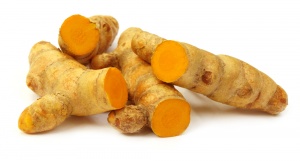Curcuma longa
| See Also | Botanical Monographs |
|---|
| Article | Turmeric and Frankincense in Inflammation: An Update, NMJ, [1], 2012 January |
|---|
Turmeric (Curcuma longa) is best known for its use in inflammatory conditions such as osteoarthritis and rheumatoid arthritis and in the treatment of liver diseases. To explore the characteristics, medicinal uses and prescribing considerations of this herb in more detail, check out the references indicated.[1], [2]
Contents
Characteristics
AKA Crocus indicus
- Common Names: Turmeric, Indian saffron, Haldi, Jiang huang
- Family: Zingiberaceae
- Habitat: Curcuma longa is native to Southeast Asia. It prefers humid conditions and rich loamy soils.
- Parts Used: Tuber, rhizome
- Constituents: volatile oil (curcumin)
- Medicinal Actions: cholagogue, hepatic, hypolipidaemic, anti-inflammatory, antibacterial (topical, internal), and antiviral, anticancer, antioxidant, cytotoxic (topical), carminative and stomachic, antimicrobial, antitumour,
Uses
Historical Uses:
Historically, Curcuma longa has been valued as highly as ginger. It's been used for purulent opthalmia, bruising (topically), blood disorders, catarrh, and inflammatory and liver disorders.
Medicinal Uses:
| Article | Clinical Uses for a Novel Form of Bioavailable Curcurmin, NDNR |
|---|
| Article | A Whiff of Saffron Changes Hormone Levels in Women, NMJ, [2], 2012 April |
|---|
- jaundice and liver disorders
- prevention of stroke and myocardial infarction, treatment of cardiovascular degeneration
- Dementia, Alzheimer's Disease and other forms of memory loss
Prescribing Considerations
Infusions and decoctions are rarely done because of low solubility of the essential oil and curcumin in water. If the powder is taken with lecithin, it improves absorption. Traditional Indian cooking may be equivalent to a therapeutic dose.
The information provided is intended to augment the treatment from a naturopathic doctor or other trained medical professional. Although most herbs are generally safe, it is recommended that you avoid self-prescribing especially when there is an underlying ongoing medical condition, if you are on any prescription medications or if you are pregnant or breastfeeding.
Formulations and Preparation
- Culinary herb - used in many Indian dishes
- Dried root - 1.5-3g daily; or 3-9g daily
- Standardized extract - 250-500mg curcumin three times daily
- Powdered root - 0.5-1g several times daily between meals; or 4g (1 heaped tsp) daily or twice daily
Safety
The safety and prescribing considerations for this herb include:[4] [5]
- Generally regarded as safe.
- Side-effects may include rare allergic reactions, and rare and usually mild gastrointestinal effects.
- Contraindications: bile duct obstruction (because it's a cholagogue, empirical); gallstones without physician consult (speculative); stomach ulcers or excess stomach acid (speculative) but prevents ulcers from NSAIDs; pregnancy (because of it's emmenagogue and abortifacient action, empirical); women attempting conception (speculative); allergic hypersensitivity; excessive sunlight with topical use (speculative)
- Drug-Herb Interactions.[4]
- Bleomycin - Potential or theoretical beneficial or supportive interaction with professional management, prevention or reduction of drug adverse effect; Herb may reduce drug-induced pulmonary toxicity (clinical significance not established). Consider co-administration only under specialist professional management.
- Cisplatin and Related Platinum Chemotherapy Compounds - Potential or theoretical beneficial or supportive interaction; Herb may reduce drug-induced renal and neurotoxicities (clinical significance not established). Consider co-administration only under specialist professional management.
- Cyclophosphamide - Interaction likely but uncertain occurrence and unclear implications; Herb may reduced drug-induced toxicity but may also reduce effectiveness of the drug (conflicting data, clinical significance not established). Avoid until further data available.
- Cyclosporine and Related Immunosuppressive Agents - Bimodal or variable interaction with professional management, impaired drug absorption and bioavailability - Precautions Appropriate, potential or theoretical beneficial or supportive interaction with professional management; Herb may enhance immunosuppressive efficacy of the drug, but also risks possible reduction in drug bioavailability (clinical significance not established). Consider co-administration only under specialist professional management with serum monitoring of drug levels.
- Doxorubicin and Related Anthracycline Chemotherapy - Interaction likely but uncertain occurrence and unclear implications, bimodal or variable interaction with professional management; Herb protects against and reduces drug-induced cardiotoxicity and may reduce drug-induced resistance (effect on drug efficacy controversial, clinical significance not established). Avoid co-administration until further data available.
- Ethanol - Prevention or reduction of drug adverse effect, beneficial or supportive interaction with professional management; Herb reduces alcohol-related pathologies in liver, pancreas, and central nervous system (clinical significance not established). Incorporate into natural treatment protocols for alcohol-related conditions.
- Indomethacin, Related Nonsteroidal Anti-inflammatory Drugs (NSAIDs), and Other Ulcerogenic Substances - Beneficial or supportive interaction with professional management, prevention or reduction of drug adverse effect; Herb may reduce incidence and promote healing of drug-induced gastric ulcerations (clinical trial suggests turmeric is no different than antacids for healing ulcers). Consider co-administration.
- Paclitaxel and Related Taxanes - Potential or theoretical beneficial or supportive interaction with professional management; Herb may chemosensitize malignant cells to drug (clinical significance not established). Consider co-administration only under specialist professional management.
- Vinblastine, Related Vinca Alkaloids, and Platinum Chemotherapy Compounds - Potential or theoretical beneficial or supportive interaction with professional management; Herb may reduce drug resistance by inhibition of efflux mechanisms. Consider co-administration only under specialist professional management.
References
- ↑ Boon Heather, Smith Michael (2009) 55 Most Common Medicinal Herbs, Second Edition Institute of Naturopathic Education and Research, CCNM Toronto.
- ↑ Godfrey Anthony, Saunders Paul, Barlow Kerry, Gowan Matt (2011) Principles and Practices of Naturopathic Botanical Medicine, Advanced Botanical Medicine. V3 CCNM Press, Toronto.
- ↑ Oh SW, Cha JY, Jung JE, Chang BC, Kwon HJ, Lee BR, Kim DY (Jul 2010) Curcumin attenuates allergic airway inflammation and hyper-responsiveness in mice through NF-kappaB inhibition. J Ethnopharmacol PubMedPMID: 20643202.
- ↑ 4.0 4.1 Stargrove Mitchell Bebell, Treasure Jonathan, McKee Dwight L (2008) Herb, Nutrient, and Drug Interactions, Clinical Implications and Therapeutic Strategies.
- ↑ Brinker Francis (1997) Herbal Contraindications and Drug Interactions: Plus Herbal Adjuncts With Medicines, 4th Edition Eclectic Medical Publications.
